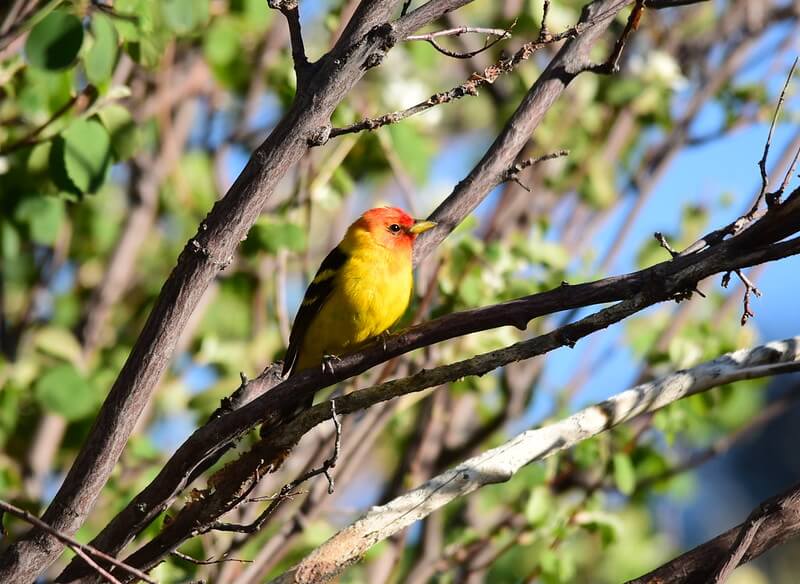by Leah Grunzke
Broadcast 6.2.2015 and 8.13.2019

Leafy spurge (Euphorbia esula L.). Photo by Ivar Leidus, CC 3.0.
Listen:
“What exactly is a weed? This can be a tricky question to answer. A plant that is nurtured and cultivated by one gardener may be yanked out unapologetically by the next, in favor of something preferable. It seems that a weed to one person can be a prized plant to another.
In Montana, where plant life plays an essential role in wildlife habitat and agriculture, we are becoming familiar with a type of weed whose qualities we agree to dislike. These “noxious weeds” are legally defined species, listed by the Montana Weed Control Act. They’re plants that make land unfit for agriculture, forestry, or livestock grazing, altering habitat in detrimental ways for native wildlife or changing wildfire dynamics or reducing native plant abundance. Almost all of Montana’s noxious weeds evolved elsewhere and were introduced to this region.
Traditionally, controlling noxious weeds has centered on preventing introduction of new plants, removing existing weeds by hand or with chemicals, or introducing predators to slow their spread. However, increasing our understanding of weed ecology may ultimately prove to be the best defense against this invasive onslaught.
Many of our weedy species arrived here from Europe and Asia. Once freed from the natural population checks of their native ranges, these exotics become aggressive competitors with our indigenous species. Invasives often produce abundant seeds, and are adapted to a wide range of soils and climates. These characteristics provide an obvious advantage when it comes to reproduction and survival, but some interesting puzzles remain. Many common garden plants evolved overseas and were introduced here, yet didn’t become noxious weeds. What is it about the combination of foreign soil, access to water and nutrients, or predators in a region that allows one exotic species to take over, while many other introduced species remain unobtrusive?
The key to answering these questions, according to University of Montana ecologists John Maron and Ray Callaway, lies in taking a biogeographic approach to studying invasive plant populations. It’s said that, in order to know where you are, you must first understand where you’ve been. The same goes for plant ecology. Studying what factors control the populations of these exotic invaders where they are native may very well reveal the secret to their success where they are introduced. This requires an innovative approach to scientific research, crossing both geographic and cultural boundaries.
Maron and Callaway are at the forefront of this movement. Their labs have teamed up with scientists from across Europe and Asia in a cross-continental comparison of two of our most threatening weed species, spotted knapweed and leafy spurge. Their studies currently focus on the role soil microbes play in helping or hindering exotic invaders’ spread.
Soil microbes that suppress North American native plants’ growth often have no effect on, or may even benefit, invasive weeds. In contrast, these soil microbes seem to be suppressing weeds in their native range. Does this account for their vastly different success rates in Europe and North America? By comparing the interactions between soil biota and plants in their native and introduced ranges, Maron and Callaway hope to pinpoint exactly what role these microbes play.
This biogeographic approach has benefits beyond a better understanding of invasive plant ecology. It unites people with vastly different life experience in the common pursuit of conserving biodiversity and protecting the livelihood of our communities. In the future, this integrated approach to understanding exotic invaders will certainly be a key tool in our efforts to manage this threat to our local plants and wildlife.”
Every week since 1991, Field Notes has inquired about Montana’s natural history. Field Notes are written by naturalists, students, and listeners about the puzzle-tree bark, eagle talons, woolly aphids, and giant puffballs of Western, Central and Southwestern Montana and aired weekly on Montana Public Radio.
Click here to read and listen to more Field Notes. Field Notes is available as a podcast! Subscribe on iTunes, Google Play, or wherever you listen to podcasts.
Interested in writing a Field Note? Contact Allison De Jong, Field Notes editor, at adejong [at] montananaturalist [dot] org or 406.327.0405.
Want to learn more about our programs as well as fun natural history facts and seasonal phenology? Sign up for our e-newsletter! You can also become a member and get discounts on our programs as well as free reciprocal admission to 300+ science centers in North America!












